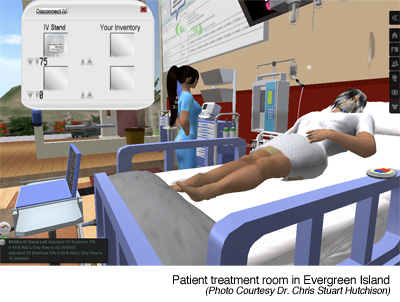
A plane crashes into a chemical plant. Scattered amid the smoking wreckage lie the bodies of the dead and wounded. Nurse-in-training Adam Nelson approaches each survivor. But instead of speaking to the victims, Nelson clicks on their images. A text box appears on Nelson’s computer screen, listing each patient’s symptoms.
Nelson is learning “triage” skills through a Second Life disaster simulation, part of the University of Wisconsin Oshkosh online bachelor’s in nursing degree program. Second Life is a virtual world where users interact in real time with each other, using three-dimensional versions of themselves, called avatars.
Nursing schools nationwide are increasingly incorporating virtual learning into their online healthcare degree programs using systems like Second Life. Some programs use virtual reality to stage scenarios that would be too costly or too difficult to create in real life. UW-Oshkosh’s use of Second Life to simulate an online nursing disaster drill is a great example employing virtual reality for training purposes. Other programs use virtual reality systems to create virtual patient labs or to mimic classroom discussions.
Teaching with Virtual Reality — Nursing Degrees Online
John Miller is a 3D virtual nursing instructor at Tacoma Community College in Washington state. He has been teaching online courses using Second Life for nursing degree students for years. “Students tend to learn better than with textbooks,” he says. “Second Life helps them learn to apply information and work through complicated scenarios.”
Miller teaches online at “Evergreen Hospital,” a virtual hospital with an operating room, patient treatment room, and a four-bed ward with nursing station. (See photo above.) He is able to create patient avatars of any age, ethnicity, height, weight and medical condition, and can control their actions and vital signs—all with the click of a mouse. Miller can speak as if he were the patient so that the nursing students can interact verbally as well.
“Students can assess—and I can change—what happens to the patient,” says Miller. With one click, he can have his virtual patient talk, moan, cough or experience a “code” event, so that nursing students learn how to use a crash cart, albeit a virtual one. These activities aren’t meant to replace real-life, hands-on practice with actual patients, but rather to familiarize healthcare students with procedures, routines, terminologies and ways of thinking.
Second Life — Cost-Effective Training for Online Nursing Schools
Using Second Life patient avatars instead of costly medical mannequins saves money and is “adaptable to training and decision-making outside of what a real-life simulation lab is used for,” says Cathy Walker, who runs a company with Miller (MUVErs, Inc.) that creates immersive online learning environments. “Second Life gives you the opportunity to see symptoms and basically treat them, in a sense, using technology,” says Nelson. “And you don’t have to worry about doing real harm to them!”
creates immersive online learning environments. “Second Life gives you the opportunity to see symptoms and basically treat them, in a sense, using technology,” says Nelson. “And you don’t have to worry about doing real harm to them!”
 creates immersive online learning environments. “Second Life gives you the opportunity to see symptoms and basically treat them, in a sense, using technology,” says Nelson. “And you don’t have to worry about doing real harm to them!”
creates immersive online learning environments. “Second Life gives you the opportunity to see symptoms and basically treat them, in a sense, using technology,” says Nelson. “And you don’t have to worry about doing real harm to them!”Other uses for Second Life in nursing include hosting classes, seminars and discussions. UW-Oshkosh’s distance learning program boasts four Second Life “islands.” The program features virtual facilities such as inpatient and outpatient clinics, a public health department, library and a house where students can practice safety checks.
Wisconsin’s online students chat about their clinical practice sessions in a virtual replica of the campus’ Pollock Alumni House.
“They sit around in comfy chairs in front of the fireplace,” says Dawn Pope, coordinator of the Oshkosh online degree program. “They talk about their clinical experiences and learn from each other. They really tend to like that.”
Nelson agrees. “Even though you’re not actually physically sitting across the room from someone, it feels like that—you’re able to hear them and interact with them. It was great!”
